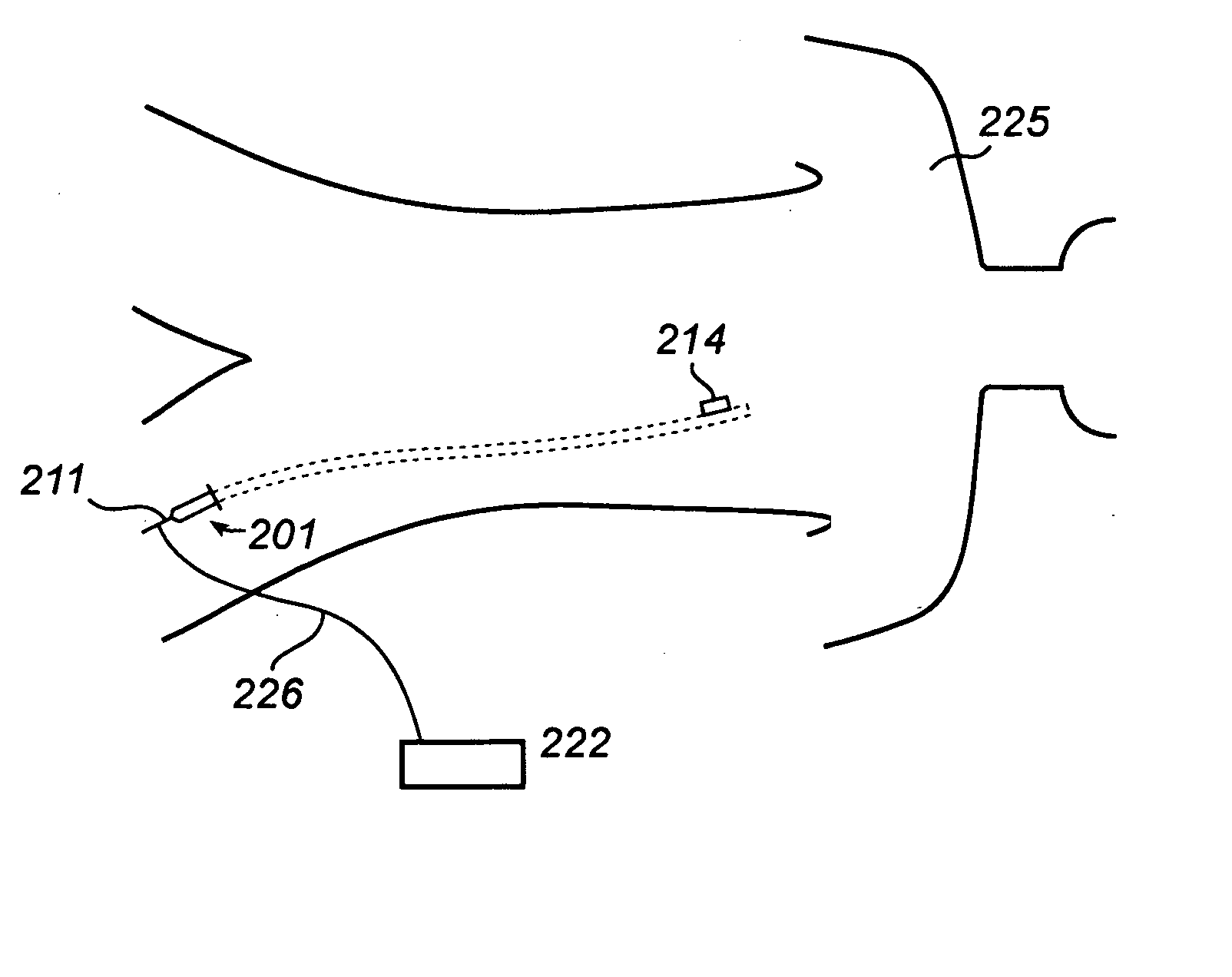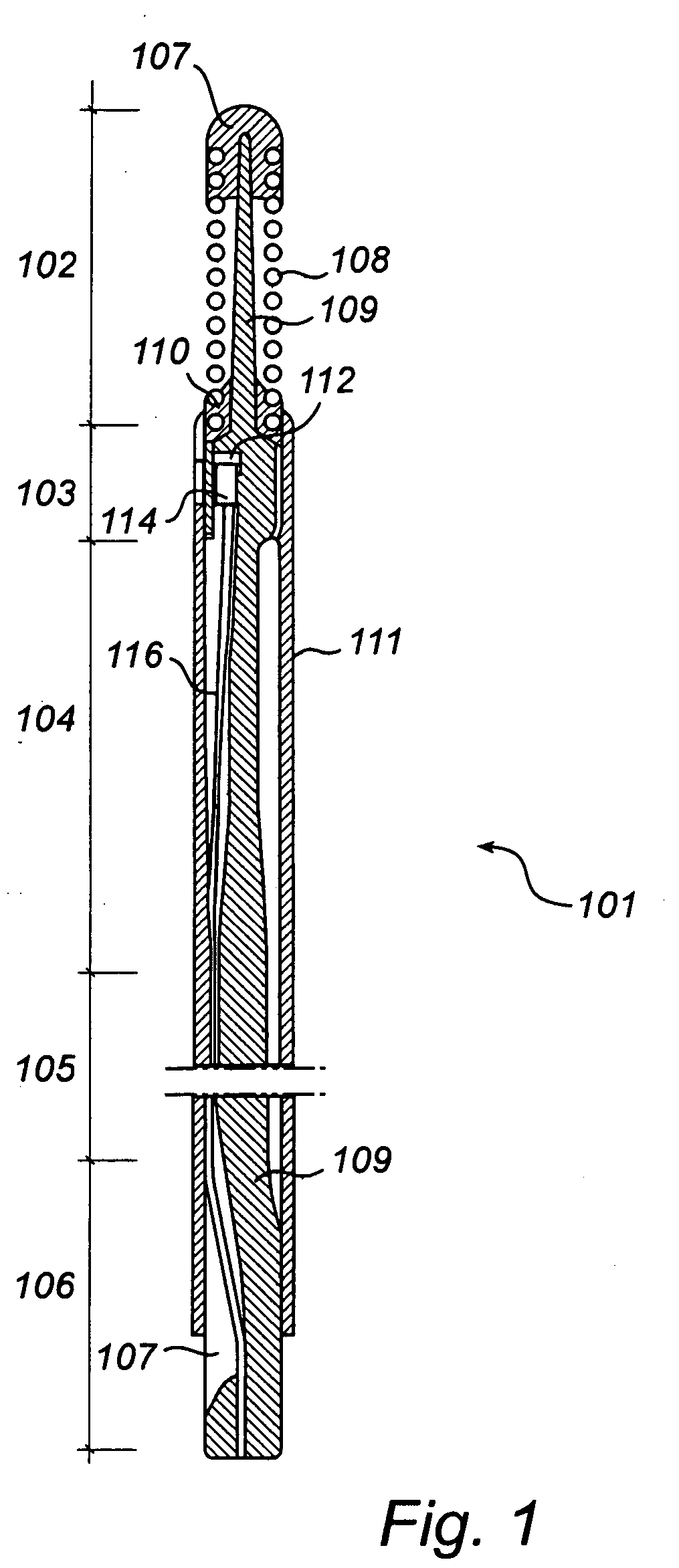[0017] The present invention is advantageous for a number of reasons. For example, the modulator for modulating the
carrier signal with the
signal representing the measured physiological variable may be located at the control unit, instead of being located in the body in direct proximity to the sensor, as in prior art systems. Hence, when placing the modulator outside the body, standard modulation circuitry may be employed, as size requirements are greatly mitigated as compared to placing the modulator in the body. Also, standard circuitry are usually off-the-shelf products that are comparatively inexpensive, and time of delivery of this type of circuitry is generally short. The overall complexity of the measuring system according to the present invention, in particular when considering production,
assembly and installation aspects, decreases considerably. Moreover, efficiency with regard to supply
voltage provision increases as the supply voltage is provided to the sensor via the guide wire. In the prior art, when supply voltage must be transmitted through tissue of a body, the efficiency generally becomes lower.
[0019] When performing this type of physiological measurement, there is generally a need for a monitoring device, such as a computer and an associated computer screen, for monitoring the measured variables after
demodulation. Typically, the monitoring device is provided with
software that allows different arithmetic operations and
signal processing algorithms to be performed on the measured variables, as well as providing an environment in which the variables may be displayed in a meaningful manner, which environment may comprise diagrams, coordinate system axes, tables, curves, etc. This device is normally located on some distance from the control unit, the sensor and the object itself, e.g. a
human body. Moreover, the monitoring device is typically connected to the mains supply, from which a 230V AC voltage may be provided. Since the parts of the system of the present invention that are located in vicinity of the object on which measurements are performed, i.e. the control unit, the sensor and related circuitry, preferably should be as small as possible in order to simplify management of the measurement system during operation, it is advantageous if the monitoring device can provide the system with a sufficient supply voltage, since any power source arranged at the control unit thus may be eliminated.
[0020] From the monitoring device, it may also possible to send
control data to the measuring system. For example, an operator of the monitoring device may want to control the number of acquired signals from the sensor, the rate with which data is transferred, control signals to a possible
microcontroller arranged at the control unit, etc. The
control data should be used at the monitoring device in a modulation process of a monitor device
carrier signal, in a manner such that the
control data does not cause interference with the supply voltage signals that are sent from the monitoring device to the control unit via the
wireless interface. Due to the fact that the interface between the monitoring device and the control unit is
wireless, any cables and connectors to connect the control unit to the monitoring device will be eliminated, which is highly advantageous during operation of the system. Hence, the monitoring device should be provided with modulation circuitry in order to perform modulating operations on signals transferred across the
radio frequency interface. In practice, the system may be used in an environment such as a hospital for measuring a physiological variable inside the body of a patient. Since personnel performing the measurements, by means of the system in accordance with the present invention, requires
free space for movement in the vicinity of the patient,
elimination of cables is highly advantageous.
[0021] It is possible that the monitoring device is arranged receive a number of modulated signals from a number of control units and to provide a representation of the measured physiological variables that correspond to the received modulated signals. In that case, each control unit is arranged such that the signals sent from a specific control unit is provided with an identifier such that the monitoring device may identify signals originating from that specific control unit. This may, for example, be effected by means of transmitting the signal from the control unit to the monitoring device at a unique frequency or by modulating the
carrier signal with a unique signal that identifies the control unit. One monitoring device can thus advantageously be used to provide representations of measured physiological variables originating from a number of control units.
[0022] According to another embodiment of the present invention, the control unit is arranged such that it may be powered via a power supply interface. Typically, a power source in the form of a DC battery is arranged at the control unit to provide the control unit with a sufficient supply voltage via the power supply interface. This has the
advantage that the measurement system does not have to rely on the monitoring device for a supply voltage. In another embodiment, the control unit is provided with both the
radio frequency interface and the power supply interface. Further, a switch is arranged to selectively provide the control unit with a supply voltage from the
radio frequency interface or the power supply interface. The battery may thus be used as a back-up, or complement, to the power delivered by the monitoring device. Monitoring device power may also be employed to charge the battery.
[0023] According to a further embodiment of the invention, the radio frequency interface of the control unit is arranged such that communication of the control unit supply voltage is performed by means of
inductive coupling between the control unit and the device with which it is communicating via the radio frequency interface. By employing an
inductive coupling in the wireless interface, relatively low operating frequencies may be employed in the system, which has the
advantage that the system becomes less sensitive to electromagnetic disturbances.
 Login to View More
Login to View More  Login to View More
Login to View More 


